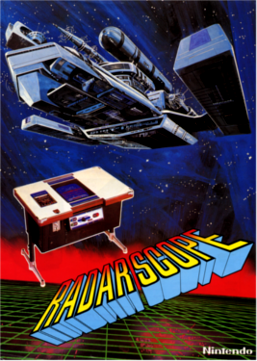Radar Scope
| Radar Scope | |
|---|---|

Arcade flyer of Radar Scope.
|
|
| Developer(s) | Nintendo R&D1 |
| Publisher(s) | Nintendo |
| Composer(s) | Hirokazu Tanaka |
| Platform(s) | Arcade game |
| Release date(s) | |
| Genre(s) | Fixed shooter |
| Mode(s) | 1 to 2 players, alternating turns |
| Cabinet | Upright, cockpit, cocktail |
| CPU |
Z80 @ 3.072 MHz, i8035 @ 400 kHz |
| Sound | DAC audio |
| Display |
Raster (vertical), full-color Sanyo monitor, 224×256 resolution, 521 out of 768colors |
Radar Scope (レーダースコープ?) is an early cabinet arcade game developed and published by Nintendo in December 1979. It is a shooter that can be viewed as a cross between Taito's Space Invaders and Namco's Galaxian. It was released in three types of arcade cabinets: upright, cockpit, and cocktail. It didn't become that popular and was considered to be a commercial failure.
Contrary to popular belief, it was not Nintendo's first arcade video game. Prior Nintendo games include EVR Race (released only in Japan), Computer Othello (released only in Japan), Sheriff (released in the U.S. by Exidy as Bandido), Space Fever (released only in Japan), and Space Firebird (released by Nintendo and Gremlin Industries in the U.S.).
Radar Scope was the first game that Shigeru Miyamoto helped develop. The game's key innovation was its three-dimensional third-person perspective, which was imitated years later by shooters such as Konami's Juno First and Activision's Beamrider. Although Radar Scope was only a modest success in North America, it was more successful in Japan, where it was second only to Pac-Man in popularity for some time. Miyamoto's more popular Donkey Kong was based on Radar Scope's hardware, and used surplus Radar Scope cabinets.
...
Wikipedia
